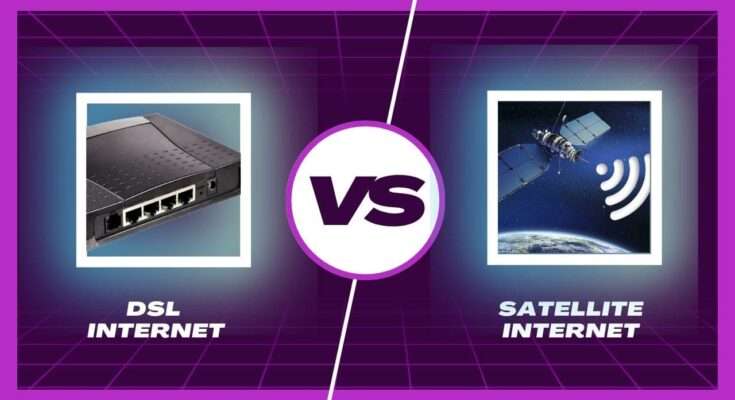Satellite Internet vs DSL: Which is better? A topic that became even more interesting in 2025, with both undergoing various updates to meet the demands of modern lifestyles. The article will dig into the latest updates, major differences, and factors users should consider when making the right decision for their requirements.
DSL vs satellite: Key Differences
DSL (Digital Subscriber Line) uses telephone lines to send data from one point to another so that users can access the internet without interrupting their voice calls. It is generally high speed and quick, and works best when the user is near the provider’s network hub, giving steady speeds and reliability in most urban and suburban areas.
What Is Satellite Internet?
Satellite internet offer access via communications satellites orbiting the Earth. This just might be the technology of choice for places in rural and remote areas where there simply are no conventional wired connections. Satellite wifi sends and receives data signals from satellite dishes installed location and satellites in space, thus usable almost anywhere as long as the sky is clear.
Key Highlight: DSL vs Satellite Internet
| Feature | DSL Internet | Satellite Internet |
|---|---|---|
| Technology | Telephone lines | Satellites (LEO/GEO/MEO) |
| Availability | Urban/suburban, some rural areas | Almost everywhere globally |
| Speed | 15–50 Mbps (can vary) | 25–200 Mbps (Starlink, Viasat) |
| Latency | Low (good for gaming/video calls) | Higher, improving with LEO |
| Reliability | Stable, weather-resistant | Can be affected by weather |
| Pricing | Generally lower | Higher, but more competitive |
| Best For | Everyday use, streaming, gaming | Rural/remote, off-grid use |
Speed and Performance
In general, DSL internet offers download speeds between 15 and 50 Mbps, with speeds falling off the further you are from the provider’s center office. Upload speeds tend to be slower, which can interfere with video calls and the transfer of large files.
Satellite internet speeds, meanwhile, have gotten much better with the rise of LEO providers such as Starlink (speeds of around 200 Mbps and lower latencies than those of geostationary satellites). Nevertheless, weather i.e., heavy rain or heavy snow may still play their role in outages in particular.
Availability and Coverage
DSL can be found almost all over the places that have the established telephone infrastructure. However, not all phone companies that are in the business of telephone also are in the business of running a DSL line, so your experiences may differ depending on your immediate location and your distance from the network access point.
Satellite internet can claim near-universal coverage, making it the best option for rural users or those traveling to remote locations that do not have the choice of cable internet, fiber internet, or DSL. For all practical purposes, if you have a clear view of the southern sky, you are good to go on satellite internet.
Pricing and Costs
DSL is, on the whole, more affordable, offering more speed for your monthly dollar than the satellite. Installation fees and activation fees may be applicable, but it is the ongoing fees that tend to be on the low end.
Satellite goes on to keep costing much money, especially when it is about those paying top dollar for speed. Leasing equipment and installation fees are the order of the day, and your monthly rate can be higher than DSL. However, competition among satellite internet providers is driving prices down and improving value.
Reliability and User Experience
Most of the time, DSL is more dependable and will not be interrupted by weather or environmental influences. It’s a good option for events that demand a solid connection, such as gaming or video conferencing. It has
The time the satellite’s Wi-Fi is interrupted by the weather is still there. However, with the introduction of new satellite technologies, especially with LEO constellations, interruptions have become fewer and uptime has risen up to 99.9% with some providers.
Which is Better: DSL vs Satellite?
Well, that depends on where you are and what you want from the Internet:
If it’s in an urban city or suburban area with DSL access, it’s almost definitely better for its reliability, lower latency, and cost-effectiveness.
In areas where wired connections are absent in the areas of rural and remote areas, satellite internet is the only option. Satellite internet providers, like Starlink, have bridged the gap in performance, offering speeds and latency that have the same approach as that of wired connections.
Conclusion: Which Is Best For You?
The choice between satellite Internet and DSL would depend on one’s location, budget, and preferences. What anyone gets with DSL Internet is adequate and reliable for the population in any urban or suburban prime area. For the people living in the rural areas, you need the satellite Internet as a lifeline and constant improvements bare being made on Internet speed with the working days to keep it going. In the end, it is about contenders taking stock of their needs and taking whichever offers the greatest support for their digital lifestyle come 2025.



